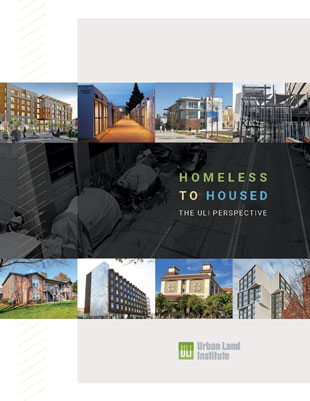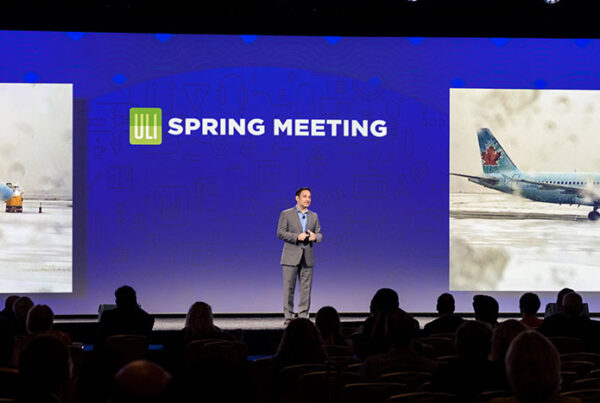A survey of ULI members suggests that the COVID-19 pandemic has resulted in commercial building management and operational changes that make occupants’ health and wellness a top priority, according to participants in a recent webinar hosted by the Institute’s Building Healthy Places Initiative.
The event featured panelists Joseph Allen, associate professor at Harvard University’s T.H. Chan School of Public Health; Jonathan Bauer, sustainability manager for The Tower Companies, a multiservice real estate firm based in Washington, D.C.; and moderator Deborah Cloutier, president and founder of RE Tech Advisors, a real estate consulting and advisory services firm headquartered in Falls Church, Virginia. The webinar and survey results are available at ULI Knowledge Finder.
The survey, A Transformative Year: Impacts of 2020 on Real Estate, was conducted for ULI by RE Tech Advisors in April 2021 and includes responses from nearly 300 U.S. real estate professionals.
Cloutier noted that the survey grouped findings in terms of building, human, and financial impact. In terms of impact on buildings, the survey measured specific health and safety measures implemented due to the pandemic, and whether this shift in operations influenced owners and managers to pursue wellness certifications. For financial impact, the survey measured the extent of lease adjustments and budget and operating cost ramifications. And for human impact, the survey’s focus shifted to the social unrest of 2020, measuring the interest in implementing diversity, equity, and inclusion initiatives.
“The coronavirus created some dramatic shifts in real estate operations, and together with the country’s racial reckoning, a new era has been ushered in with profound implications for the future of the industry,” Cloutier said.
Key takeaways include the following:
- Building managers and operators pivoted quickly to respond to the pandemic.
- Advanced filtration, mask wearing, temperature checks, and other measures were prevalent, as were enhanced communication strategies.
- Survey respondents forecast that many health-oriented building changes are here to stay.
- The industry wanted more guidance from the government and other sources on how to navigate an unprecedented situation, especially when it comes to the COVID response.
- Flexibility was prevalent in navigating the financial impacts of the pandemic, with 80 percent of respondents implementing rent concessions and other measures.
- Many companies responded to the country’s racial reckoning by adopting enhanced diversity, equity, and inclusion measures.
Half the survey respondents said they faced no barriers to implementing changes in response to the pandemic. Seventy-four percent implemented space layout changes; and 66 percent put in place building occupancy restrictions. Twenty-four percent implemented equipment and operational measures (an additional 10 percent had done this prior to COVID).
The most common equipment and operational measures were increased outdoor air, followed by installation of highly efficient MERV-13 air filters (MERV is an acronym for Minimum Efficiency Reporting Value, the primary rating system used for air filtration); natural ventilation; and increased air flow. Respondents indicated that equipment upgrades were the changes most likely to be permanent, while occupancy control and spacing restrictions were the changes most likely to be temporary.
Cloutier noted that a lack of funding was cited as the top barrier keeping respondents from implementing more expensive measures such as equipment changes, while less expensive measures related to occupancy control and space layout were far easier to quickly put in place. Still, taken together, all the actions point to the health of buildings becoming a top consideration by the real estate community, she said. “The pandemic set in overdrive a trend already emerging—that being the trend of healthy buildings,” Cloutier said.
Focus on Air Quality
Allen said that scientific evidence has shown COVID to be transmitted by poor indoor air circulation, rather than by touching surfaces—a finding that should propel a much greater emphasis throughout the real estate community on improving air ventilation and filtration. “COVID is an indoor virus; all the cases have occurred in under-ventilated locations. Knowing that it is spread primarily through airborne transmission will lead to a fundamental shift in how we design and construct buildings,” he said.
Allen pointed to ULI’s survey responses indicating that deep cleaning was implemented more often than air quality improvements—a finding that he said suggests that the industry must shift its focus to the true cause of the problem.
“Shared air is the problem, not shared surfaces. The reality is we are breathing others’ air all the time because of poor ventilation,” he said. “Our building design standards for air quality are not performance-based standards that are designed for health—they are minimum standards. So, we have buildings that meet minimum standards at most, and then a pandemic hit that involves an airborne respiratory virus—that is the recipe for the disaster that we have had.”
In addition to COVID, the medical community has found other respiratory viruses to be airborne, adding to the urgent need to develop new standards for air quality that better protect the health of building occupants and users, he said. “As yet, we have largely ignored indoor air quality, but that will change,” said Allen. “This is really about taking the pulse of the building—you really don’t know how it is performing unless you are actively measuring and monitoring what’s happening in the space.”
Building users and occupants are becoming increasingly informed about indoor air quality, and are using devices such as hand-held sensors to measure carbon dioxide levels in all types of spaces, he noted. “People are reporting on air quality in buildings and holding building managers, owners, and operators accountable,” Allen said. “This represents a paradigm shift, in that this information is no longer privately held by a building owner or tenant or air quality consultant. If you [building owners and managers] are not constantly measuring this, you need to start now.”
A health-based standard for air quality could be set by an organization such as the American Society of Heating, Refrigerating and Air-Conditioning Engineers; the Centers for Disease Control and Prevention; or the World Health Organization to help provide clarity on what constitutes a healthy indoor environment, Allen said. And, as the business community becomes increasingly focused on preventing disease transmission through improved air quality, it is equally important that air quality be treated as one part of a holistic healthy building strategy that includes other factors such as mental well-being of occupants and tenants, he added.
Health and Sustainability at the Center in Operations
Bauer noted that despite the prevailing assumption that improving buildings’ air quality means sacrificing energy efficiency, Tower is applying new data and smart technologies and employing dedicated professionals to balance both goals. “It doesn’t have to be one or the other—we [the industry] can definitely do both, but we cannot operate the way we operated prior to COVID. The traditional way of operating buildings needs to be changed,” Bauer said.
Since the start of the pandemic, Tower has significantly enhanced air quality monitoring across its portfolio, using a system that measures more than 50 metrics in five-minute intervals—a large and complex data set that can appear overwhelming, but yields key information to improve building performance from both a health and energy standpoint, he said. “We are getting more comfortable with this data and using it to operate our buildings,” he said.
Bauer said that one of Tower’s properties in Washington, D.C., is serving as a pilot to test state-of-the-art smart building technology involving a partnership with Prescriptive Data, a commercial real estate technology company, and the Department of Energy’s Lawrence Berkeley National Laboratory. The system generates thousands of data points from occupancy sensors and other features and scans the data to determine precisely when the building’s air ventilation system needs to be operating the next day—factoring in weather and temperature changes—to provide an optimal level of comfort to occupants without wasting energy.
“What we are doing is implementing energy efficiency without sacrificing health,” Bauer said. “Actually, it is better for health, because the system can predict what each space needs based on use by people and real-time conditions. We are learning how to use data to maximize energy efficiency and maximize health. This is a new area for the industry, and I think you will see more companies bringing people in house with that expertise to drive all of this.”
Added Cloutier: “I think that fundamentally, our industry needs to get over the idea that you have to have a tradeoff between energy efficiency and health and that focusing on one means a deficit of the other. You can have energy-efficient buildings and healthy spaces, and we need to elevate the importance of both.”
The webinar was the latest in a series of webinars hosted by the Building Healthy Places Initiative to help members understand the role they can play in advancing sustainability, health, and social equity throughout the built environment.
The survey results and a recording of the webinar are available on Knowledge Finder.


